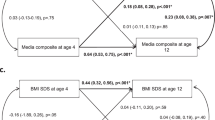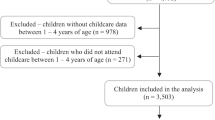Abstract
OBJECTIVE:
To determine if there is a relationship between center-based child care attendance from ages 3 to 5 y and future overweight at ages 6–12 y.
DESIGN/METHODS:
Longitudinal, observational study of child experience and future body mass index.
SUBJECTS:
A total of 1244 US children aged 6–12 y included in the 1997 Panel Study of Income Dynamics Child Development Supplement.
MEASUREMENTS:
Parent-reported child care attendance from ages 3 to 5 y, trichotomized as ‘none’, ‘limited’ (>0 but <15 h/week), and ‘extensive’ (≥15 h/week). Overweight defined as a body mass index ≥95th percentile for age and gender. Candidate covariates (selected a priori): gender, race, age, poverty status, birth weight, hours of television per day, Behavior Problems Index score >90th percentile, and Home Observation for Measurement of the Environment-Short Form (HOME-SF) cognitive stimulation score.
RESULTS:
Of the potential confounding variables, race, HOME-SF cognitive stimulation score, and age significantly altered the relationship between child care attendance and overweight in the multiple logistic regression model. With these covariates in the final model, limited center-based child care attendance from ages 3 to 5 y was independently associated with a decreased risk of overweight at ages 6–12 y (adjusted odds ratio=0.56, 95% confidence interval 0.34, 0.93) relative to no child care attendance. Extensive center-based child care attendance was not associated with future overweight.
CONCLUSIONS:
Limited center-based child care attendance during the preschool years was independently associated with a decreased risk of future overweight relative to no child care attendance. Additional studies are needed to clarify these findings.
This is a preview of subscription content, access via your institution
Access options
Subscribe to this journal
Receive 12 print issues and online access
$259.00 per year
only $21.58 per issue
Buy this article
- Purchase on Springer Link
- Instant access to full article PDF
Prices may be subject to local taxes which are calculated during checkout
Similar content being viewed by others

References
Hedley A, Ogden C, Johnson C, Carroll M, Curtin L, Flegal K . Prevalence of overweight and obesity among US children, adolescents, and adults, 1999–2002. JAMA 2004; 291: 2847–2850.
Strauss R, Pollack H . Epidemic increase in childhood overweight. JAMA 2001; 286: 2845–2848.
Ogden C, Flegal K, Carroll M, Johnson C . Prevalence and trends in overweight among US children and adolescents, 1999–2000. JAMA 2002; 288: 1728–1732.
Whitaker R, Wright J, Pepe M, Seidel K, Dietz W . Predicting obesity in young adulthood from childhood and parental obesity. N Engl J Med 1997; 337: 869–873.
Strauss R, Knight J . Influence of the home environment on the development of obesity in children. Pediatrics 1999; 103: e85.
O'Loughlin J, Gray-Donald K, Paradis G, Meshefedjian G . One- and two-year predictors of excess weight gain among elementary schoolchildren in multiethnic, low-income, inner-city neighborhoods. Am J Epidemiol 2000; 152: 739–746.
Dowda M, Ainsworth B, Addy C, Saunders R, Riner W . Environmental influences, physical activity, and weight status in 8- to 16-year-olds. Arch Pediatr Adolesc Med 2001; 155: 711–717.
Berkey C, Rockett H, Gillman M, Colditz G . One-year changes in activity and in inactivity among 10- to 15-year-old boys and girls: relationship to change in body mass index. Pediatrics 2003; 111: 836–843.
Andersen R, Crespo C, Bartlett S, Cheskin L, Pratt M . Relationship of physical activity and television watching with body weight and level of fatness among children: results from the Third National Health and Nutrition Examination Survey. JAMA 1998; 279: 938–942.
Crespo C, Smit E, Troiano R, Bartlett S, Macera C, Andersen R . Television watching, energy intake, and obesity in US children: results from the Third National Health and Nutrition Examination Survey, 1988–1994. Arch Pediatr Adolesc Med 2001; 155: 360–365.
Lee Y, Mitchell D, Smiciklas-Wright H, Birch L . Diet quality, nutrient intake, weight status, and feeding environments of girls meeting or exceeding recommendations for total dietary fat of the American Academy of Pediatrics. Pediatrics 2001; 107: e95.
Sobal J, Stunkard A . Socioeconomic status and obesity: a review of the literature. Psychol Bull 1989; 105: 260–275.
Troiano R, Flegal K . Overweight children and adolescents: description, epidemiology, and demographics. Pediatrics 1998; 101: 497–504.
Peth-Pierce R . The NICHD Study of Early Child Care. NICHD: Bethesda, MD; 1998.
Helburn S, Bergmann B . America's child care problem: the way out. Palgrave MacMillan: New York, NY; 2002.
Birch L, Davison K . Family environmental factors influencing the developing behavioral controls of food intake and childhood overweight. Ped Clin N Am 2001; 48: 893–907.
Nafstad P, Hagen J, Magnus P, Jaakkola J . Day care centers and respiratory health. Pediatrics 1999; 103: 753–758.
Bradley R, National Institute of Child Health and Human Development Early Child Care Research Network. Child care and common communicable illnesses in children aged 37 to 54 months. Arch Pediatr Adolesc Med 2003; 157: 196–200.
Brooks-Gunn J, Han W, Waldfogel J . Maternal employment and child cognitive outcomes in the first three years of life: the NICHD Study of Early Child Care. National Institute of Child Health and Human Development. Child Dev 2002; 73: 1052–1072.
National Institute of Child Health and Human Development Early Child Care Research Network. Early child care and self-control, compliance, and problem behavior at twenty-four and thirty-six months. Child Dev 1998; 69: 1145–1170.
Carter R . The impact of public schools on childhood obesity. JAMA 2002; 288: 2180.
Stolley M, Fitzgibbon M, Dyer A, Horn L, KaugerChristoffel K, Schiffer L . Hip-Hop to Health Jr, an obesity prevention program for minority preschool children: baseline characteristics of participants. Prev Med 2003; 36: 320–329.
Fitzgibbon M, Stolley M, Dyer A, VanHorn L . A community-based obesity prevention program for minority children: rationale and study design for Hip-Hop to Health. Jr Prev Med 2002; 34: 289–297.
Castro Jd, Brewer E . The amount eaten in meals by humans is a power function of the number of people present. Physiol Behav 1992; 51: 121–125.
Hofferth S, Davis-Kean P, Davis J, Finkelstein J . The Child Development Supplement to the Panel Study of Income Dynamics 1997 user guide. University of Michigan: Ann Arbor, MI; 1997.
Ogden C, Troiano R, Briefel R, Kuczmarski R, Flegal K, Johnson C . Prevalence of overweight among preschool children in the United States, 1971 through 1994. Pediatrics 1997; 99: e1.
Lumeng J, Gannon K, Cabral H, Frank D, Zuckerman B . The association between clinically meaningful behavior problems and overweight in children. Pediatrics 2003; 112: 1138–1145.
Kuczmarski R, Ogden C, Grummer-Strawn L, Flegal K, Guo S, Wei R . CDC growth charts. Adv Data 2000; 314: 1–28.
Welfare reform. Implications of increased work participation for child care. Report No. HEHS-97-75. United States General Accounting Office: Washington, DC; 1997.
Zotov N, Keng S, Hamilton W . Family child care providers in the CACFP: operational effects of reimbursement tiering: a report to congress on the family child care homes legislative changes study. Report No. 02-004. Economic Research Service: Washington, DC; 2002.
National Institute of Child Health and Human Development Early Child Care Research Network. Infant child care and attachment security: results of the NICHD Study of Early Child Care. Child Dev 1997; 68: 860–879.
National Institute of Child Health and Human Development Early Child Care Research Network. The relationship of child care to cognitive and language development. Society for Research in Child Development: Washington, DC; 1997.
Parsons T, Power C, Manor O . Fetal and early life growth and body mass index from birth to early adulthood in 1958 British cohort: longitudinal study. BMJ 2001; 323: 1331–1335.
Zill N, Peterson J . Behavior problems index. Child Trends Inc.: Washington, DC; 1986.
Achenbach T, Edelbrock C . Manual for the Child Behavior Checklist and Revised Child Behavior Profile. University of Vermont, Department of Psychology: Burlington, VT; 1983.
Gortmaker S, Walker D, Weitzman M, Sobol A . Chronic conditions, socioeconomic risks, and behavioral problems in children and adolescents. Pediatrics 1990; 85: 267–276.
Caldwell B, Bradley R . Home Observation for Measurement of the Environment. University of Arkansas at Little Rock, Center for Child Development and Education: Little Rock, AR; 1984.
Gortmaker S, Must A, Sobol A, Peterson K, Colditz G, Dietz W . Television viewing as a cause of increasing obesity among children in the United States, 1986–90. Arch Pediatr Adolesc Med 1996; 150: 356–362.
Diggle P, Liang K, Zeger S . Analysis of longitudinal data. Clarendon Press: Oxford, UK; 1994.
Rothman K, Greenland S . Modern epidemiology. Lippincott-Raven: Philadelphia, PA; 1998.
Bradley R, Corwyn R, McAdoo H, Coll C . The home environments of children in the United States part I: variations by age, ethnicity, and poverty status. Child Dev 2001; 72: 1844–1867.
Anonymous . Early childhood and child care study: summary of findings. USDA: Washington, DC; 1997.
National Institute of Child Health and Human Development Early Child Care Research Network. Child care and children's peer interaction at 24 and 36 months. Child Dev 2001; 72: 1478–1500.
Anonymous . Work and family: child care arrangements of young working mothers. Report No. 820. Bureau of Labor Statistics: Washington, DC; 1992.
DuRant R, Baranowski T, Johnson M, Thompson W . The relationship among television watching, physical activity, and body composition of young children. Pediatrics 1994; 94: 449–454.
Dietz W, Gortmaker S . Do we fatten our children at the television set? Obesity and television viewing in children and adolescents. Pediatrics 1985; 75: 807–812.
Acknowledgements
This study was supported by HRSA MCHB 5T77 MC00015 09 and the American Heart Association Fellow-to-Faculty Transition Award 0274050N as salary support to Dr Lumeng, and the Joel and Barbara Alpert Endowment for Children of the City Grant for statistical consultation and programming.
Author information
Authors and Affiliations
Corresponding author
Rights and permissions
About this article
Cite this article
Lumeng, J., Gannon, K., Appugliese, D. et al. Preschool child care and risk of overweight in 6- to 12-year-old children. Int J Obes 29, 60–66 (2005). https://doi.org/10.1038/sj.ijo.0802848
Received:
Revised:
Accepted:
Published:
Issue Date:
DOI: https://doi.org/10.1038/sj.ijo.0802848
Keywords
This article is cited by
-
Changing the preschool setting to promote healthy energy balance-related behaviours of preschoolers: a qualitative and quantitative process evaluation of the SuperFIT approach
Implementation Science (2021)
-
Relationships Between the Home Learning Environment, Weight Status, and Dietary Intake: Results From a Cross-Sectional Study of Preschool-Aged Children in New South Wales, Australia
The Journal of Primary Prevention (2021)
-
Migration background and childhood overweight in the Hannover Region in 2010–2014: a population-based secondary data analysis of school entry examinations
European Journal of Pediatrics (2018)
-
Association of childcare arrangement with overweight and obesity in preschool-aged children: a narrative review of literature
International Journal of Obesity (2017)
-
The relationship between childcare and adiposity, body mass and obesity-related risk factors: protocol for a systematic review of longitudinal studies
Systematic Reviews (2016)


